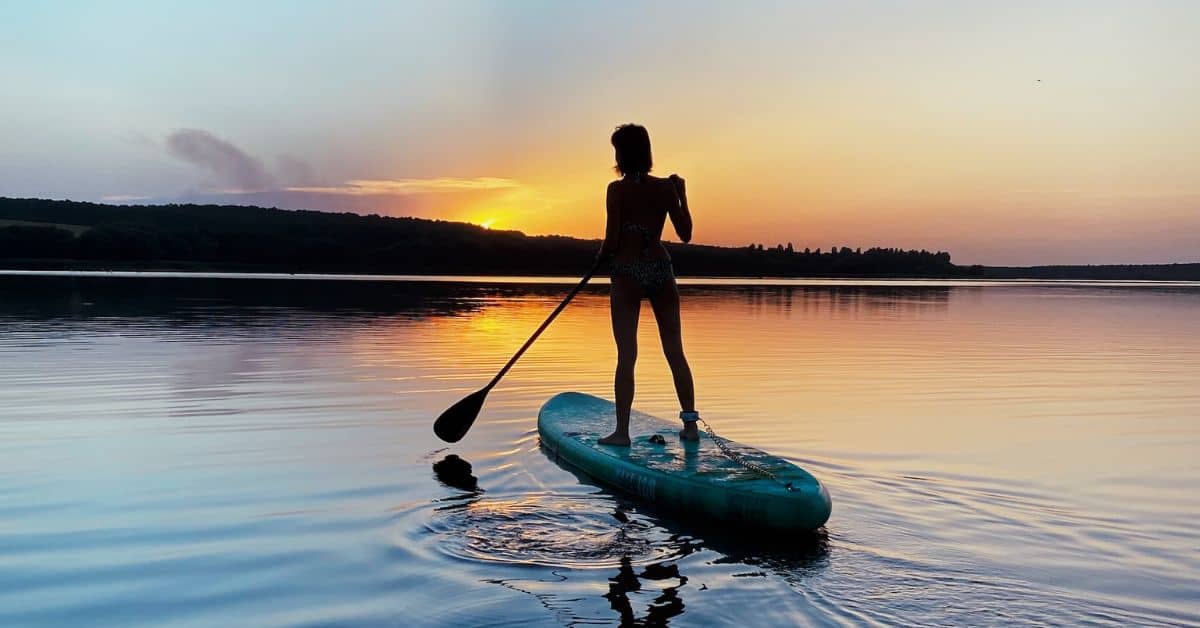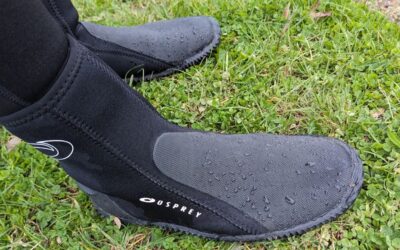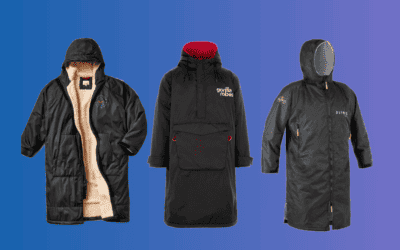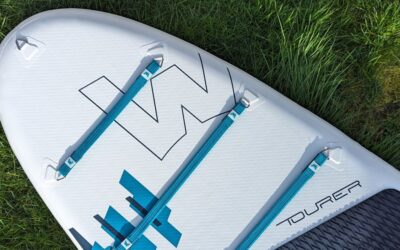Paddle boarding is a popular water sport that combines relaxation, fitness, and adventure. Whether you’re a beginner learning how to paddle board for the first time or an experienced paddler, choosing the right attire can greatly enhance your experience on the water.
In this article, we’ll explore what to wear paddle boarding and provide you with useful tips to ensure comfort, safety, and style during your paddle boarding sessions.
What To Wear Paddle Boarding?
Before we delve into what to wear, let’s briefly discuss the basics of paddle boarding, also known as stand up paddleboarding (SUP).
Paddle boarding involves standing on a large board commonly referred to as a SUP and using a paddle to navigate across the water. It offers a unique way to explore rivers, lakes, and oceans while enjoying the tranquillity of nature and can be a leisurely activity or a challenging workout, depending on your goals and the conditions you choose to take paddle boards out in.
However, to make the most of your paddle boarding experience, it’s essential to dress appropriately for the activity.
Wearing the proper attire while paddle boarding serves several purposes.
Firstly, it ensures your comfort by providing protection against the elements and minimizing discomfort caused by wet or restrictive clothing.
Secondly, it enhances safety by allowing freedom of movement and providing visibility to others on the water.
Lastly, choosing the proper attire can also help you express your personal style and make a fashion statement while enjoying your time on the paddle board.
Disclaimer: If you make a purchase via the links on our site, I may earn an affiliate commission at no additional cost to you. You can read my affiliate disclosure in the privacy policy. Thanks for your support!
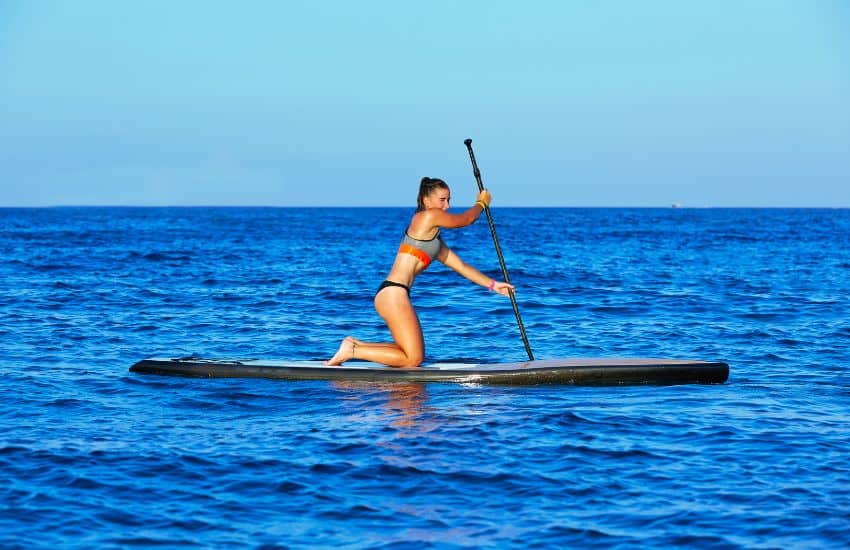
Factors to Consider When Choosing Paddle Board Clothing
When deciding what to wear for paddle boarding, several factors should be taken into account. These factors include water conditions, weather conditions, the type of paddle boarding you’ll be doing, and your personal preferences.
Water Conditions
The water conditions play a crucial role in determining the appropriate attire. If you’ll be paddle boarding in warm, calm waters, your clothing choices may differ from those for choppy or cold water conditions. It’s important to consider the air temperature and potential contact with water when selecting your outfit.
Weather Conditions
The weather conditions on the day of your paddle boarding adventure will influence your attire choices too. For sunny and hot weather, sun protection becomes essential, while cooler or windy conditions may require additional layers for warmth and wind protection.
Type of Paddle Boarding
The type of paddle boarding activity you plan to engage in also affects your clothing choices. If you’re planning a leisurely paddle on calm waters, your attire may differ from that of someone seeking a more adventurous experience, such as SUP surfing or racing. Consider the specific demands of your paddle boarding activity when selecting your outfit.
Personal Preference
Lastly, your personal preferences should be taken into account. Some individuals may prioritize functionality and performance, while others may place more emphasis on style and fashion. Finding a balance between personal style and practicality is key when choosing what to wear for paddle boarding.
Essential Clothing for Paddle Boarding
Now let’s explore the essential clothing items to consider for your paddle boarding outfit:
Swimwear
A good starting point for paddle boarding attire is swimwear. Opt for comfortable and well-fitting swimsuits that allow freedom of movement. Women may prefer one-piece swimsuits or bikinis with secure straps, while men may opt for swim trunks or board shorts.
Rash Guard or Sun Protection Shirt
To protect your skin from the sun’s harmful rays and potential irritation caused by paddling, wearing a rash guard or a sun protection shirt is highly recommended. These lightweight and breathable shirts offer UPF (Ultraviolet Protection Factor) to shield your skin from UV radiation.
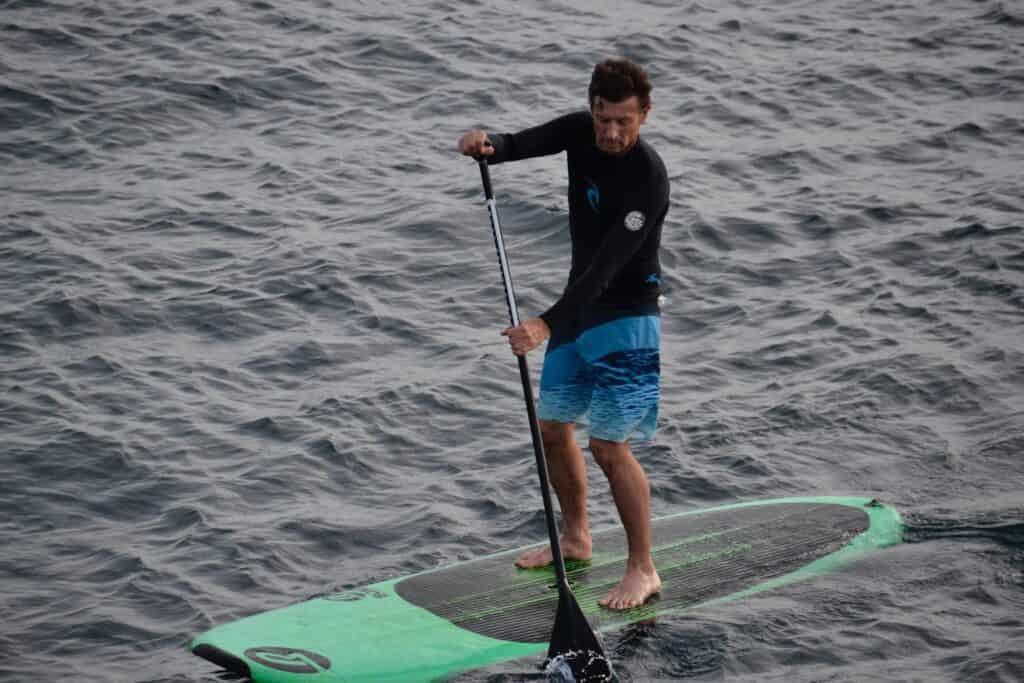
Board Shorts or Leggings
For bottom wear, board shorts or leggings are popular choices among paddle boarders. Board shorts provide comfort, flexibility, and quick-drying properties. Leggings made of moisture-wicking and stretchy materials are suitable for cooler conditions or for added sun protection.
Wetsuit or Drysuit (Optional)
In cold water conditions or during cooler seasons, wearing a wetsuit or drysuit can provide insulation and protection against the cold weather, especially if winter paddle boarding. Wetsuits are made of neoprene and provide thermal insulation even when wet. Drysuits, on the other hand, are waterproof suits that keep you dry by preventing water from entering.
Footwear

While paddle boarding, you’ll want footwear that provides grip and protects your feet from sharp objects or rough surfaces. Water shoes, neoprene boots or booties, or sandals with a secure strap are ideal choices. Avoid wearing regular sneakers as they can become heavy and uncomfortable when wet.
Hat and Sunglasses
To shield yourself from the sun and improve visibility, wearing a hat with a brim and sunglasses is essential. A wide-brimmed hat helps protect your face, neck, and ears from sunburn, while polarized sunglasses reduce glare and enhance visual clarity on the water.
Changing Robe

Whilst not strictly for wearing while paddleboarding a changing robe offers convenience and privacy when transitioning from water to land. With its spacious design and easy-to-use features, a changing robe allows you to change comfortably without worrying about exposure. It will keep you snug and warm, protected from the elements once out of the water. It’s a must-have accessory for hassle-free post-paddle outfit changes.
Related Article: The Best Dryrobe Alternatives
Choosing the Right Material
Selecting the appropriate material for your paddle boarding attire is crucial for comfort and performance. Here are some factors to consider when choosing the fabric:
Quick-Drying and Moisture-Wicking Fabrics
Opt for clothing made from materials that dry quickly and wick moisture away from your skin. These fabrics, such as polyester or nylon blends, help keep you comfortable by preventing excessive moisture buildup.
Sun Protection Factor (SPF)
Look for clothing with a high SPF rating to shield your skin from harmful UV radiation. Some fabrics are specifically designed to offer UV protection, providing an additional layer of defence against sunburn.
Breathability and Comfort
Choose lightweight and breathable fabrics that allow air circulation and prevent overheating. Fabrics with mesh panels or ventilation features can enhance breathability and keep you cool during intense paddling sessions.
What To Wear PaddleBoarding During Different Seasons
The appropriate attire for paddle boarding varies depending on the season. Here’s a breakdown of what to consider for each season:
Summer
During the summer months, prioritize lightweight and breathable clothing. Opt for moisture-wicking fabrics to keep sweat at bay and choose clothing items that offer maximum sun protection.
Wear swimwear or a rash guard, board shorts or leggings, and don’t forget your hat and sunglasses. Remember to apply sunscreen to any exposed skin.
Spring and Autumn
During transitional seasons, the weather can be unpredictable. Layering is key to adapting to changing conditions.
Start with a base layer of moisture-wicking clothing, such as a long-sleeved shirt and leggings. Depending on the temperature, add a lightweight jacket or a wetsuit/drysuit for an extra layer of insulation.
Adjust your layers as needed to maintain comfort throughout your paddle boarding session.
Winter
Cold weather paddle boarding in the winter months requires additional precautions to stay warm and safe.
Wear a thicker wetsuit or drysuit to provide insulation against cold water. Layer up your bathing suit with insulating base layers, such as thermal tops and bottoms, and add a waterproof and windproof outer layer.
Don’t forget warm socks and gloves to protect your extremities from the cold when winter paddleboarding.
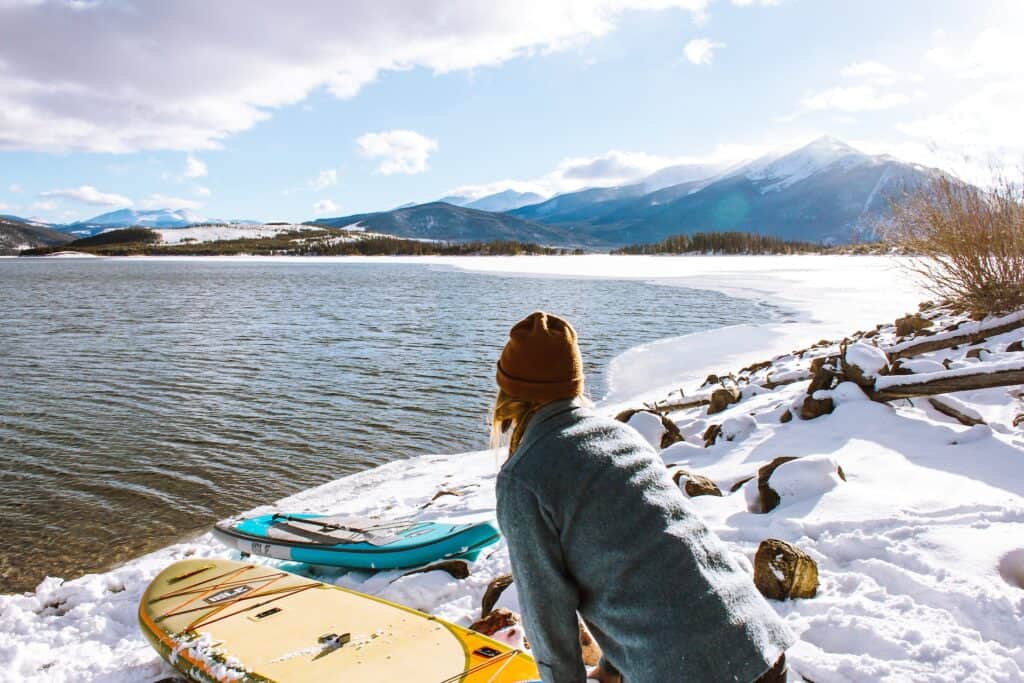
Safety Considerations
When it comes to deciding what to wear paddleboarding, safety should always be a top priority. Here are some safety considerations to keep in mind:
Personal Flotation Device (PFD)
Wearing a personal flotation device, commonly known as a PFD or life jacket, is crucial for your safety on the water. Choose a PFD that is comfortable, properly fitted, and approved by relevant authorities.
Leash
A leash is an essential safety accessory that tethers you to your paddle board. It helps prevent separation from your board in case of falls or strong currents. Make sure to attach the leash securely to your ankle or calf.
Bright or Reflective Clothing
To enhance your visibility to other water users, consider wearing bright-colored or reflective clothing. This makes it easier for boaters and other paddlers to spot you, especially in crowded or low-light conditions.
Accessories and Extras
In addition to the essential clothing items, there are some accessories and extras that can enhance your paddle boarding experience:
Waterproof Bag
Carrying a waterproof bag ensures that your personal belongings, such as keys, mobile phone, and snacks, stay dry throughout your adventure. Look for a bag that is designed to be waterproof and buoyant.
Sunscreen
Protecting your skin from harmful UV rays is crucial, even on cloudy days. Apply a waterproof sunscreen with a high SPF rating to any exposed skin before heading out on the water. Don’t forget to reapply as needed.
Water Bottle
Staying hydrated is important during physical activities. Bring a reusable water bottle that is easy to secure to your board or keep in a waterproof bag.
Action Camera
Capture your paddle boarding memories by using an action camera. Mount it securely on your board or wear it on a head strap or chest harness to record your adventures.
Maintaining Your Gear
To prolong the lifespan of your paddle boarding clothing, it’s important to take care of your gear:
Washing and Drying
After each paddle boarding session, rinse your clothing with fresh water to remove salt, sand, or any contaminants. Follow the manufacturer’s instructions for washing and drying to maintain the fabric’s integrity.
Storing Properly
Store your gear in a cool and dry place, away from direct sunlight. Hang or fold them neatly to prevent creasing or stretching.
Regular Inspections
Inspect your paddle boarding attire regularly for any signs of wear and tear. Check for loose threads, worn-out fabrics, or damaged zippers. Replace any gear that is no longer in optimal condition to ensure your safety and comfort.
Tips for Paddle Boarding Outfits
Here are some additional tips to consider when choosing and styling your paddle boarding outfits:
Layering
Layering allows you to adjust your clothing according to changing weather conditions. Start with a moisture-wicking base layer, add insulating layers for warmth, and top it off with a waterproof and windproof outer layer if necessary.
Avoiding Cotton
Cotton absorbs and retains moisture, which can make you feel cold and uncomfortable during paddle boarding. Opt for synthetic or wool-based materials that wick moisture away from your skin and keep you dry.
Dressing for Balance and Mobility
Choose clothing that allows for a full range of motion and doesn’t restrict your movements on the paddle board. Avoid loose or baggy clothing that may get caught on equipment or hinder your balance.
Final Thoughts
Choosing the right clothing for paddle boarding is essential for your comfort, safety, and enjoyment on the water.
Consider the water and weather conditions, the type of paddle boarding you’ll be doing, and your personal preferences when selecting your outfit.
Opt for quick-drying and moisture-wicking fabrics, prioritize sun protection, and don’t forget safety accessories like a PFD and leash. With the right attire, you can make the most of your paddle boarding experience while looking stylish and feeling confident.
What To Wear Paddle Boarding FAQ
Can I wear a regular t-shirt and shorts for paddle boarding?
While it’s possible to wear a regular t-shirt and shorts, it’s not the most ideal choice. Regular clothing tends to absorb water and may cause discomfort or hinder your movements. It’s best to opt for moisture-wicking and quick-drying materials designed for water sports.
Do I need a wetsuit for paddle boarding?
The need for a wetsuit depends on the water temperature and personal preference. In colder months or conditions, a wetsuit provides insulation and keeps you warm. However, in warmer climates, a wetsuit may not be necessary. Assess the water temperature and dress accordingly to ensure your comfort.
Can I wear flip-flops while paddle boarding?
While flip-flops are easy to slip on and off, they are not recommended for paddle boarding. They can easily come off in the water, leaving you barefoot and at risk of injury. Instead, choose water shoes, or neoprene shoes, booties, or sandals with secure straps for better protection and grip.
Should I wear a hat and sunglasses while paddle boarding?
Yes, wearing a hat and sunglasses is highly recommended. A hat with a brim provides sun protection for your face, neck, and ears, while sunglasses with polarized lenses reduce glare and enhance visibility on the water. Protecting your eyes and skin from the sun is crucial during outdoor activities.
How often should I inspect and replace my paddle boarding attire?
Regularly inspect your paddle boarding attire for any signs of wear and tear. Check for loose threads, worn-out fabrics, or damaged zippers. It’s important to replace any gear that is no longer in optimal condition to ensure your safety and comfort on the water.

About the Author
Steve Cleverdon is an adventure blogger dedicated to helping outdoor enthusiasts make the most of their outdoor experiences. With years of travel and many epic adventures including a 3000-kilometre solo hike across New Zealand, Steve has amassed practical knowledge on outdoor gear. You can learn more about his adventures here. Through expert reviews, recommendations, and guides, he equips his readers with the best gear for their next adventure. If you want to send Steve a quick message, visit his contact page here.

